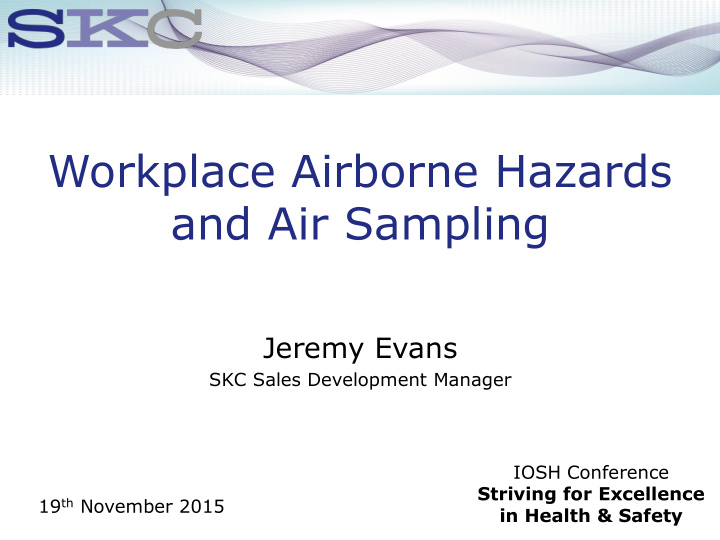



Workplace Airborne Hazards and Air Sampling Jeremy Evans SKC Sales Development Manager IOSH Conference Striving for Excellence 19 th November 2015 in Health & Safety
Size of the Problem? Recreation Bristol Home Park, Ground, Bath Balloon Plymouth Argyle Festival 1 mg/m 3 1 ppm contents of a party balloon one teaspoon of flour spread over a in the volume of 50 rugby/football field, three bedroom houses to a height of one metre
Size of the Problem? Safety Health 142 12,000 - 13,000 Pareto’s Principle - 80:20 Rule does not apply Deaths due to airborne exposure 99:1
Health Diseases Cancers COPD Lung Cancer Occupational Asthma Silicosis Chronic Bronchitis Mesothelioma Emphysema Leukaemia Asbestosis etc Rhinitis etc Benzene Butadiene Asbestos Formaldehyde Isocyanates Respirable Wood Dust Styrene Crystalline Silica Rubber Dust/Fume Welding Dust Fume Wood, Flour, Chromic Acid Mist Particulates Cotton, etc Nickel Cadmium
Getting the Balance right ???? 2050 1950 2040 1960 1970 2030 2020 1980 1990 2010 2000
Getting the Balance right Safety Health
Airborne Exposure - Focus? Less Focus on ENT CONTROLS PURPOSE OF CONTROLS: MINIMISE PERSONAL EXPOSURE IS EXPOSURE ACTUALLY MEASURED ?
Costs? CONTROLS AIR SAMPLING LEV, Suppression, RPE, etc Equipment, Analysis (Lab) What Does it Cost NOT to do Air Sampling?
Reasons for Workplace Air Sampling Health Protection • Compliance with Government Legislation • – COSHH: Control of Substances Hazardous to Health – EH40: HSE Workplace Exposure Limits – CLAW: Control of Lead at Work Regulations – CAR: Control of Asbestos Regulations Compensation Claims • Effective Control Measures •
Exposure Limits in the Workplace • EH40:2005 – WEL’s (Workplace Exposure Limits) – 8 Hour (Time Weighted Average) – 15 Min (Short Term Exposure Limit) Vapours OTHER EXPOSURE LIMITS • e.g. USA • OSHA - PEL’s (Permissible Exposure Limits) • NIOSH - REL’s (Recommended Exposure Limits) • ACGIH - TLV’s (Threshold Limit Values)
What is Air Sampling? Air is passed through a filter, tube or other collecting media • Hazard Presence/Level detected by • – Direct Reading (Dust) or – Colour Change of Media (Vapours) or – Laboratory Analysis (Dust, Silica, Metals, Vapours)
Passive Sampling • Diffusion • Semi-quantitative (Indicator) • Immediate results (Gastec, Dräger) Grab Sampling • Small sample volume • Semi-quantitative (Indicator) • Not Time-Based Exposure Active Sampling • Compensating Pump • Quantitative - Known Flow Rate & Time • Much Larger Sample Volume 12
Sampling Train Connecting Tube Pump • Connecting tube • Sampler Sampler • Pump Active Sampling Setup Sampling Train • Calibrator Calibrate Flow Rate - Before Sampling • Flow Rate Measurement Fit Sample Train to Operator • Check Flow Rate - After Sampling • Send Sample to Laboratory • Review Results • – Actual Exposure vs 8 hr WEL 15 min STEL
Personal vs Static Sampling Workplace Exposure Limits (WELS) based on PERSONAL SAMPLES MUST be taken in the BREATHING ZONE
Particulates • General Dust • Wood Dust- Mills, Furniture, Workshops, Paper • Fumes - Welding, Solder, Rubber, etc • Metals - Electroplating, Grinding, Cutting, etc • Fibres - Asbestos, Mineral, Ceramic, Silica • Flour/Grain Dust - Mills, Bakeries • Rubber Process Dust • Diesel Particulates • Mining – Coal, etc • Cotton, Wool Dust 15
Inhalable Dust Size Distribution BS EN 481:1993 • Up to 100 micron AED • Affects ALL the respiratory system • Partially visible • Workplace Exposure Limits - Dust 10 mg/m 3 8 Hours - Hard Wood & Soft Wood Dust 5 mg/m 3 8 Hours
Respirable Dust Size Distribution BS EN 481:1993 • Up to 12 micron AED • Penetrates Deep into the Lungs • Invisible • Workplace Exposure Limits - Dust 4 mg/m 3 8 Hours - Respirable Crystalline Silica 0.1 mg/m 3 8 Hours
Air Sampling - Particulates Sampling Heads (containing a Filter) Mini Sampler IOM Cyclone Cowled Welding Fume Inhalable Dust Respirable Dust Fibres Components Metals Silica Asbestos (Metals) Cleaning Processes Direct Reading TIMES Dust Monitor
Vapours • Organic Chemicals – solvents / VOCs, etc – Benzene, Toluene, Formaldehyde, Methanol, etc • Inorganic Chemicals - mineral acids – Hydrochloric Acid, Nitric Acid, Sulphuric Acid, etc • Gases – Nitrous Oxide, Chlorine, Chloroform, etc • Isocyanates
Vapours - Exposure Limits (WELs) Parts per Million (ppm) • Wide Range • – Vapours – Limits Examples 8 Hour TWA 15 Minute STEL • – Formaldehyde 2 ppm 2 ppm – Xylene 50 ppm 100 ppm – Dichloromethane 100 ppm 300 ppm – Propan-2-ol (IPA) 400 ppm 500 ppm
Passive/Grab Sampling - Vapours Passive Sampling Badges Colour Change Tubes
Active Sampling - Vapours Sorbent Tube with Holder & Cover Cassette & Holder (containing treated filter)
HSE Methods MSDS - Method for the Determination of Hazardous Substances Dust - MDHS 14/4 - Dust: Respirable, Thoracic & Inhalable - MDHS 101/2 - Respirable Crystalline Silica Vapours • Generic (VOCs) – MDHS 88 - Passive Sampling – MDHS 96 - Active Sampling
• WHY • WHAT • HOW • WHO? Workplace Air Sampling - Options • Consultant • DIY • Both DIY Benefits – Cost Savings – Flexibility – Involvement / Ownership – Additional Skills / Experience
Excellence The quality of being outstanding or extremely good. Air Sampling Major Step towards Excellence in H&S
Air Sampling - Exposure Measurement Don’t just rely on Controls Take the Guesswork Out Defuse the Exposure Time bombs Redress the Balance X X Safety Health
IOSH Conference Striving for Excellence In Health & Safety
Recommend
More recommend